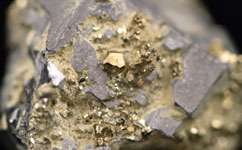Gold in them hills

The revival of Scotland's long-dormant gold-mining industry is underway, after officials gave the go-ahead to start work at a Highland mine.
The Cononish mine, near Tyndrum, could pull in as much as £20 million a year for a decade or more as long as the price of gold stays sky-high.
Nyree Hill, a PhD student in geology at the University of Leicester, is working with Scotgold Resources, the company behind the mining plans, to try to find further gold deposits. The aim is to extend the industry's economic impact in the area beyond Cononish's predicted ten-year lifetime.
"The problem is that gold is found scattered throughout the Scottish Highlands, but so far none has been found as concentrated as at Cononish," Hill explains. "This is despite the Highlands being one of the first areas in the world to be studied by geologists."
She is drawing on years of Scotgold data to analyse the gold-bearing samples that have already been found in case any point the way to deposits rich enough to be worth mining. The area is challenging for gold prospectors; its terrain is rugged and there's a thick layer of soil deposited by glaciers that makes it hard to reach the rock for sampling. Large areas of forested land add to the difficulty of exploratory digging. And for much of the year the weather can be a hindrance too.
To get round these challenges Hill is working to understand why the gold is where it is, and so make exploration more efficient by helping target areas that have the right set of conditions to form another gold deposit. She's analysing the ratios between different forms of the same element, known as isotopes, to get more insight into how the gold deposits were formed and where the best areas for exploration today might be.
Scotgold estimates that the deposits under the mine will produce 20,000 oz of gold and 80,000 of silver each year for around a decade – worth around £180m in total at today's prices. But the company hopes to have discovered more big deposits by the time they run out, so that the economic benefits from the industry can continue.
When exploratory work started there in the 1980s, Cononish promised to be the first new mine to open in Scotland since gold was mined at Leadhills 500 years ago to make the nation's crown jewels. But in the late 1990s a crash in the price of gold brought activity to an end. The gold price has increased sharply over the last few years, though, making mining at Cononish economically viable once more.
The Cononish deposit has its origins in an ancient mountain range stretching from Canada through Ireland and Scotland to Scandinavia this was before the Atlantic opened and separated these chunks of land. The mountains formed as the Iapetus Ocean, a forebear of the Atlantic, was destroyed in a collision of tectonic plates half a billion years ago, an event that also joined Scotland and England for the first time.
The gold was concentrated deep underground, as granite magma heated water, which circulated through large faults. The hot water carried gold and deposited it, with quartz, into veins. This process, repeated time and again, brought the gold to economic levels.
"Traditional exploration strategies look at how gold is related to other metals and minerals," says Hill. "However, my study is using the detailed chemistry of the gold and isotope ratios of associated minerals to map out where the gold-bearing fluid flowed. This approach will help identify future targets and maximize our chances of finding the next Cononish."
"Scotgold has been really supportive of my work. The company has lots of drillhole data from the area, and many other mining companies would never let me look at it or use the samples, but Scotgold has given me full access." she adds.
This story is republished courtesy of Planet Earth online, a free, companion website to the award-winning magazine Planet Earth published and funded by the Natural Environment Research Council (NERC).
Provided by PlanetEarth Online

















